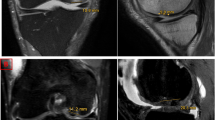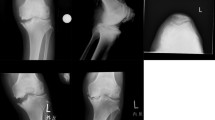Abstract
Introduction
The Kellgren–Lawrence score helps the orthopedic surgeon to classify the severity of knee osteoarthritis (OA) before total knee arthroplasty (TKA). There might be a discrepancy between subjective complaints of the patients and radiologically visible changes of the knee joint in many cases. In this context, we performed a prospective clinical study to compare the preoperative degree of knee OA using the Kellgren–Lawrence score with the intraoperative extent of cartilage damage during primary TKA.
Materials and methods
A total of 251 primary TKA surgeries due to a primary knee OA were prospectively included. Preoperative Kellgren–Lawrence score was determined using standardized preoperative plain radiographs of three views; anteroposterior, lateral and skyline of the patella by a senior radiologist. Intraoperatively, in all cases, photographs of the medial, lateral, and patellofemoral joint compartments were taken. Using the International Cartilage Repair Society (ICRS) score, the degree of chondromalacia was assessed. Subsequently, correlation analysis was performed using the Pearson–Clopper 95% confidence interval (CI).
Results
There were higher intraoperative scores compared to the preoperative scores in 160 of all cases (63.7% of 251, 95% CI 57.5–69.7%). A mismatch of two score grade points was found in 8.4% (95% CI 5.3–12.5%). The most common mismatch was noted in patients with preoperative Kellgren–Lawrence score of 3 and an intraoperative score of 4 in 48.2% (95% CI 41.9–54.6%).
Conclusions
The preoperative radiographs using Kellgren–Lawrence underestimate the severity of knee osteoarthritis. The true extent of articular cartilage damage can be better appreciated intraoperatively. In patients undergoing primary TKA, the correlation of clinical symptoms with radiological findings is crucial in deciding when to perform the surgery. Besides, other imaging modalities may be used as an adjunct when the clinical findings and plain radiographs do not correlate.




Similar content being viewed by others
References
Braun HJ, Gold GE (2012) Diagnosis of osteoarthritis: imaging. Bone 51:278–288
Wright RW, Group M (2014) Osteoarthritis classification scales: interobserver reliability and arthroscopic correlation. J Bone Jt Surg Am 96:1145–1151
Kellgren JH, Lawrence JS (1957) Radiological assessment of osteo-arthrosis. Ann Rheum Dis 16:494–502
Bedson J, Croft PR (2008) The discordance between clinical and radiographic knee osteoarthritis: a systematic search and summary of the literature. BMC Musculoskelet Disord 9:116
Altman RD, Hochberg M, Murphy WA Jr, Wolfe F, Lequesne M (1995) Atlas of individual radiographic features in osteoarthritis. Osteoarthr Cartil 3(Suppl A):3–70
Roemer FW, Crema MD, Trattnig S, Guermazi A (2011) Advances in imaging of osteoarthritis and cartilage. Radiology 260:332–354
Guccione AA, Felson DT, Anderson JJ, Anthony JM, Zhang Y, Wilson PW et al (1994) The effects of specific medical conditions on the functional limitations of elders in the Framingham Study. Am J Public Health 84:351–358
Murray CJ, Atkinson C, Bhalla K, Birbeck G, Burstein R, Chou D et al (2013) The state of US health, 1990–2010: burden of diseases, injuries, and risk factors. JAMA 310:591–608
Vos T, Flaxman AD, Naghavi M, Lozano R, Michaud C, Ezzati M et al (2012) Years lived with disability (YLDs) for 1160 sequelae of 289 diseases and injuries 1990–2010: a systematic analysis for the Global Burden of Disease Study 2010. Lancet 380:2163–2196
Goldring MB (2006) Update on the biology of the chondrocyte and new approaches to treating cartilage diseases. Best Pract Res Clin Rheumatol 20:1003–1025
Loeser RF (2011) Aging and osteoarthritis. Curr Opin Rheumatol 23:492–496
Lotz M, Loeser RF (2012) Effects of aging on articular cartilage homeostasis. Bone 51:241–248
Hunter DJ, Zhang YQ, Tu X, Lavalley M, Niu JB, Amin S et al (2006) Change in joint space width: hyaline articular cartilage loss or alteration in meniscus? Arthritis Rheum 54:2488–2495
Kijowski R, Blankenbaker D, Stanton P, Fine J, De Smet A (2006) Arthroscopic validation of radiographic grading scales of osteoarthritis of the tibiofemoral joint. AJR Am J Roentgenol 187:794–799
Schiphof D, de Klerk BM, Kerkhof HJ, Hofman A, Koes BW, Boers M et al (2011) Impact of different descriptions of the Kellgren and Lawrence classification criteria on the diagnosis of knee osteoarthritis. Ann Rheum Dis 70:1422–1427
Lanyon P, O'Reilly S, Jones A, Doherty M (1998) Radiographic assessment of symptomatic knee osteoarthritis in the community: definitions and normal joint space. Ann Rheum Dis 57:595–601
Cootes TF, Taylor CJ (2004) Anatomical statistical models and their role in feature extraction. Br J Radiol 77(Spec No 2):S133–139
Ravaud P, Chastang C, Auleley GR, Giraudeau B, Royant V, Amor B et al (1996) Assessment of joint space width in patients with osteoarthritis of the knee: a comparison of 4 measuring instruments. J Rheumatol 23:1749–1755
Seise M, McKenna SJ, Ricketts IW, Wigderowitz CA (2007) Learning active shape models for bifurcating contours. IEEE Trans Med Imaging 26:666–677
Chang CB, Yoo JH, Koh IJ, Kang YG, Seong SC, Kim TK (2010) Key factors in determining surgical timing of total knee arthroplasty in osteoarthritic patients: age, radiographic severity, and symptomatic severity. J Orthop Traumatol 11:21–27
Haynes J, Sassoon A, Nam D, Schultz L, Keeney J (2017) Younger patients have less severe radiographic disease and lower reported outcome scores than older patients undergoing total knee arthroplasty. Knee 24:663–669
Acknowledgements
We acknowledge the professional support from Mr. Sven Brügmann regarding the intraoperative high-quality photographs.
Funding
No funding was received.
Author information
Authors and Affiliations
Corresponding author
Ethics declarations
Conflict of interest
The authors declare that they have no conflict of interest regarding this manuscript. Outside the manuscript, one or more of the authors of this paper have disclosed the following disclosures: Waldemar Link, Hamburg, Germany, Zimmer Biomet, USA, Ceramtec, Heraeus.
Ethical approval
This study was performed after obtaining approval from the institutional review board. The PV number is “5367”.
Additional information
Publisher's Note
Springer Nature remains neutral with regard to jurisdictional claims in published maps and institutional affiliations.
Rights and permissions
About this article
Cite this article
Abdelaziz, H., Balde, O.M., Citak, M. et al. Kellgren–Lawrence scoring system underestimates cartilage damage when indicating TKA: preoperative radiograph versus intraoperative photograph. Arch Orthop Trauma Surg 139, 1287–1292 (2019). https://doi.org/10.1007/s00402-019-03223-6
Received:
Published:
Issue Date:
DOI: https://doi.org/10.1007/s00402-019-03223-6




